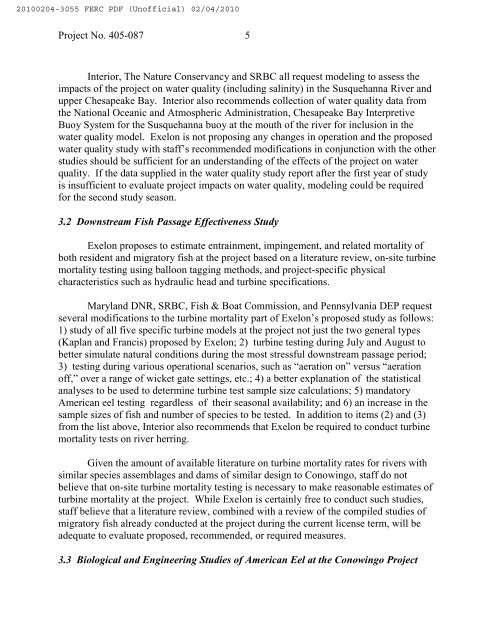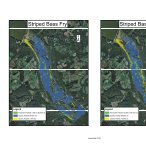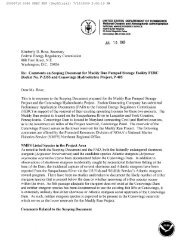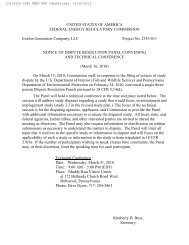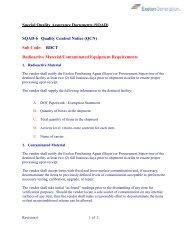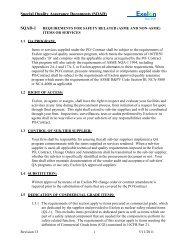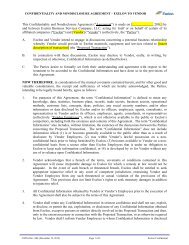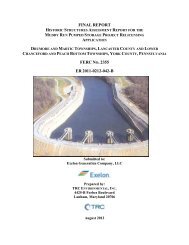FEDERAL ENERGY REGULATORY COMMISSION Project No. 405 ...
FEDERAL ENERGY REGULATORY COMMISSION Project No. 405 ...
FEDERAL ENERGY REGULATORY COMMISSION Project No. 405 ...
Create successful ePaper yourself
Turn your PDF publications into a flip-book with our unique Google optimized e-Paper software.
20100204-3055 FERC PDF (Unofficial) 02/04/2010<br />
<strong>Project</strong> <strong>No</strong>. <strong>405</strong>-087 5<br />
Interior, The Nature Conservancy and SRBC all request modeling to assess the<br />
impacts of the project on water quality (including salinity) in the Susquehanna River and<br />
upper Chesapeake Bay. Interior also recommends collection of water quality data from<br />
the National Oceanic and Atmospheric Administration, Chesapeake Bay Interpretive<br />
Buoy System for the Susquehanna buoy at the mouth of the river for inclusion in the<br />
water quality model. Exelon is not proposing any changes in operation and the proposed<br />
water quality study with staff’s recommended modifications in conjunction with the other<br />
studies should be sufficient for an understanding of the effects of the project on water<br />
quality. If the data supplied in the water quality study report after the first year of study<br />
is insufficient to evaluate project impacts on water quality, modeling could be required<br />
for the second study season.<br />
3.2 Downstream Fish Passage Effectiveness Study<br />
Exelon proposes to estimate entrainment, impingement, and related mortality of<br />
both resident and migratory fish at the project based on a literature review, on-site turbine<br />
mortality testing using balloon tagging methods, and project-specific physical<br />
characteristics such as hydraulic head and turbine specifications.<br />
Maryland DNR, SRBC, Fish & Boat Commission, and Pennsylvania DEP request<br />
several modifications to the turbine mortality part of Exelon’s proposed study as follows:<br />
1) study of all five specific turbine models at the project not just the two general types<br />
(Kaplan and Francis) proposed by Exelon; 2) turbine testing during July and August to<br />
better simulate natural conditions during the most stressful downstream passage period;<br />
3) testing during various operational scenarios, such as “aeration on” versus “aeration<br />
off,” over a range of wicket gate settings, etc.; 4) a better explanation of the statistical<br />
analyses to be used to determine turbine test sample size calculations; 5) mandatory<br />
American eel testing regardless of their seasonal availability; and 6) an increase in the<br />
sample sizes of fish and number of species to be tested. In addition to items (2) and (3)<br />
from the list above, Interior also recommends that Exelon be required to conduct turbine<br />
mortality tests on river herring.<br />
Given the amount of available literature on turbine mortality rates for rivers with<br />
similar species assemblages and dams of similar design to Conowingo, staff do not<br />
believe that on-site turbine mortality testing is necessary to make reasonable estimates of<br />
turbine mortality at the project. While Exelon is certainly free to conduct such studies,<br />
staff believe that a literature review, combined with a review of the compiled studies of<br />
migratory fish already conducted at the project during the current license term, will be<br />
adequate to evaluate proposed, recommended, or required measures.<br />
3.3 Biological and Engineering Studies of American Eel at the Conowingo <strong>Project</strong>


